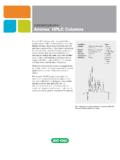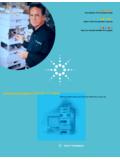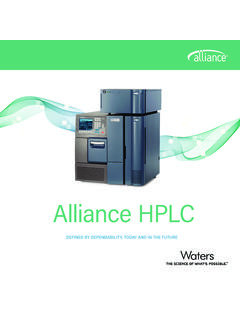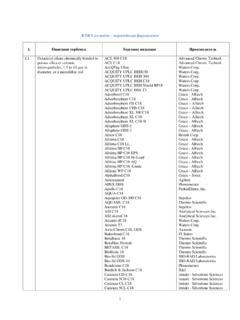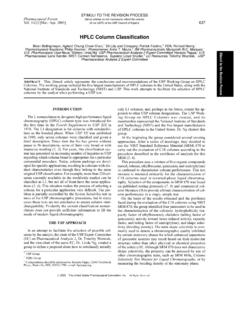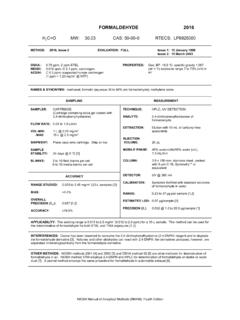Transcription of POLYNUCLEAR AROMATIC HYDROCARBONS by …
1 NIOSH Manual of Analytical Methods (NMAM), Fourth EditionPOLYNUCLEAR AROMATIC HYDROCARBONS by HPLC5506 Formulae: Table 1MW: Table 1 CAS: Table 2 RTECS: Table 2 METHOD: 5506, Issue 3 EVALUATION: PARTIALI ssue 1: 15 May 1985 Issue 3: 15 January 1998 OSHA :Table 3 NIOSH:Table 3 ACGIH:Table 3 PROPERTIES:Table 1 Compoundsacenaphthenebenzo[ghi]perylenef luoreneacenaphthylenebenzo[a]pyreneinden o[1,2,3-cd]pyreneanthracenebenzo[e]pyren enaphthalenebenz[a]anthracenechrysenephe nanthrenebenzo[b]fluoranthenedibenz[a,h] anthracenepyrenebenzo[k]fluoranthenefluo rantheneNAMES & SYNONYMS:Polycyclic AROMATIC HYDROCARBONS , PAHs; also see Table :FILTER + SORBENT TUBE(37-mm, 2- m, PTFE + washed XAD-2, 100mg/50 mg)FLOW RATE:2 L/minVOL-MIN:200 L -MAX:1000 LSHIPMENT:transfer filters to culture tubes; wrap sorbentand culture tubes in Al foil; ship @ 0 CSAMPLESTABILITY:unknown; protect from heat and UV lightFIELD BLANKS:3 to 10 field blanks per setMEDIA BLANKS:6 to 10 media blanks per setTECHNIQUE: hplc , FLUORESCENCE/UVDETECTIONANALYTE:compound s listed aboveEXTRACTION:5 mL acetonitrile.
2 Ultrasonic bath, 30 to 60minutesINJECTIONVOLUME:10 to 50 LMOBILE PHASE:acetonitrile/water gradient @ ambienttemperature, 1 mL/minCOLUMN:250 x , reversed-phase, 5- m C18 DETECTOR:UV @ 254 nm; fluorescence @ 340 nm(excitation), 425 nm (emission)CALIBRATION:standards in acetonitrileRANGE:see EVALUATION OF METHODESTIMATED LOD:see EVALUATION OF METHODPRECISION (r):see EVALUATION OF METHODACCURACYRANGE STUDIED:not determinedBIAS:not determinedOVERALLPRECISION (rT):not determinedACCURACY:not determinedAPPLICABILITY: This method is applicable to samples that can be extracted with acetonitrile. This method is not applicable to samplesthat require a different extraction solvent or contain large amounts of highly adsorptive particulate matter, , fly ash or diesel soot; also,this method is not applicable to asphalt fume : Any compound that elutes at the same hplc retention time may interfere.
3 Heat, ozone, NO2, or UV light may causesample METHODS: This revises P&CAM 206 and 251 [1]. Method 5515 uses the same sampling technique, with gas chromatographicmeasurement [2]. Method 5800 uses the same sampling technique, and a flow-injection method to determine total polycyclic aromaticcompounds at two different sets of fluorescent wavelengths [3]. POLYNUCLEAR AROMATIC HYDROCARBONS by hplc : METHOD 5506, Issue 3, dated 15 January 1998 - Page 2 of 9 NIOSH Manual of Analytical Methods (NMAM), Fourth , distilled, deionized, , hplc grade, test mixture,* a liquid standard containingthe PAHs except benzo[e]pyrene (EPA 610 POLYNUCLEAR AROMATIC HYDROCARBONS , Supelco,Cat.)
4 No. 4-8743; or equivalent). [e]pyrene,* solid (Supelco, Cat. No. 44-2475; or equivalent).* See SPECIAL PRECAUTIONSEQUIPMENT: : 37-mm, 2- m pore size, PTFE membrane filter laminated to PTFE,(Zefluor, Pall Gelman Sciences, Cat. ; SKC Inc., Cat. No. 225-17-07; orequivalent filter), cellulose spacer ring,37-mm OD, 32-mm ID, (SKC Inc., Cat. ; or equivalent) in a 37-mm cassettefilter :If sampling is to be done in brightsunlight, use opaque orfoil-wrapped cassettes to preventsample tube, washed XAD-2 resin (front =100 mg; back = 50 mg) (ORBO 43,Supelco, Cat.
5 No. 2-0258; or equivalent),connected to filter with minimum length ofPVC tubing. Plastic caps are required :If pressure drop is excessive orpump fails, use a larger diametersorbent tube with XAD-2 resin(ORBO 42 Large, Supelco, 2-0264U; or equivalent). sampling pump capable ofoperating for 8 h at 2 L/min, with flexibleconnecting tubing. foil. , bagged. tubes, PTFE-lined screw cap, 13-mmx 100-mm. filters, m, 25-mm, PTFE(Acrodisc-CR, Pall Gelman Sciences, 4219; or equivalent). , 5-mL. or micropipets, 1- to 100- , with gradient capability, fluorescence(excitation @ 340 nm, emission @ 425 nm)and UV (254 nm) detectors in series,electronic integrator, and a 250 x C18column (Vydac 201TP, The SeparationsGroup, Hesperia, CA, Cat.
6 No. 201TP54; orequivalent). flasks, 10- and : lighting in laboratoryshould be incandescent or PRECAUTIONS: Treat all POLYNUCLEAR AROMATIC HYDROCARBONS as carcinogens. Samples andunused standards are considered toxic waste. Dispose of in an appropriate manner. Counter tops andequipment should be checked regularly with a "black light" for fluorescence as an indicator ofcontamination by AROMATIC HYDROCARBONS by hplc : METHOD 5506, Issue 3, dated 15 January 1998 - Page 3 of 9 NIOSH Manual of Analytical Methods (NMAM), Fourth EditionSAMPLING: each personal sampling pump with a representative sampler in line.
7 Personal samples at 2 L/min for a total sample size of 200 to 1000 L. after sampling, transfer the filter carefully with forceps to a culture tube. Hold filter atedge to avoid disturbing the collected sample. Cap the tube and wrap in aluminum : This step is necessary to avoid loss of analytes by sublimation. the sorbent tube and wrap in aluminum foil. to laboratory in insulated container with bagged PREPARATION: NOTE:UV light may degrade PAHs; therefore, recommend using yellow, UV-absorbing shields forfluorescent lights or use incandescent lighting. samples upon receipt at laboratory.
8 PAH from mL of acetonitrile to each culture tube containing a filter. Similarly, add mL ofacetonitrile to each culture tube containing the media and reagent blanks. Cap the capped tubes in an ultrasonic bath for 30 to 60 min. PAH from each sorbent tube with a file in front of the front (larger) sorbent section. Break tube atscore front glass wool plug and front sorbent section to a culture tube. Transfer back sorbentsection, and the middle glass wool plug to a second culture mL acetonitrile to each culture tube. Cap the capped tubes in an ultrasonic bath for 30 to 60 min.
9 All sample extracts through an m syringe AND QUALITY daily with at least six working :If a benzo[e]pyrene standard is needed, weigh desired amount and add to a known volumeof the PAH test aliquots of the PAH test mixture (containing benzo[e]pyrene if needed) with acetonitrilein 10-mL volumetric flasks. The concentration range should cover most of the PAHconcentrations in the analysis, intersperse working standards with samples and calibration graphs (peak area vs. g of each PAH per sample). and desorption recovery (R) from filters and desorption efficiency (DE) from sorbent tubes at leastonce for each lot of filters and sorbent tubes used in the range of interest.
10 (1)Filters. Using a microliter syringe or a micropipette, spike four filters at each of fiveconcentration levels with a mixture of the analytes. Allow the filters to dry in the darkovernight. Analyze the filters (steps 7, 9, and 13 through 15). Prepare graphs of R found.(2)Sorbent tubes. Transfer an unused front sorbent section to a culture tube. Prepare a totalof 24 culture tubes in order to measure DE at five concentration levels plus blank inquadruplicate. Using a microliter syringe or micropipette, add calibration stock solutiondirectly to sorbent.










